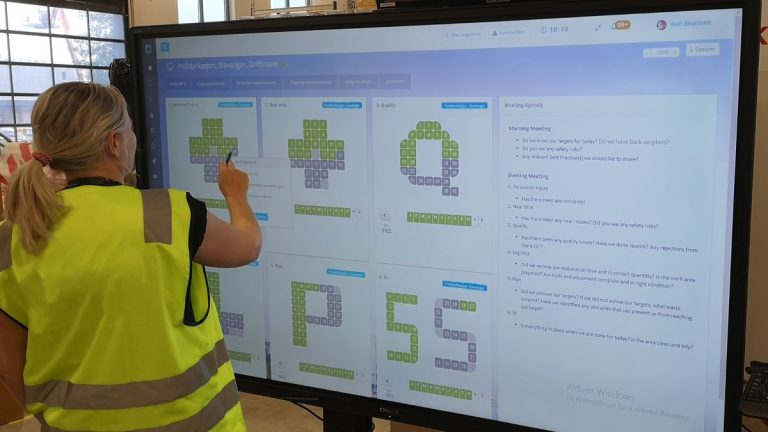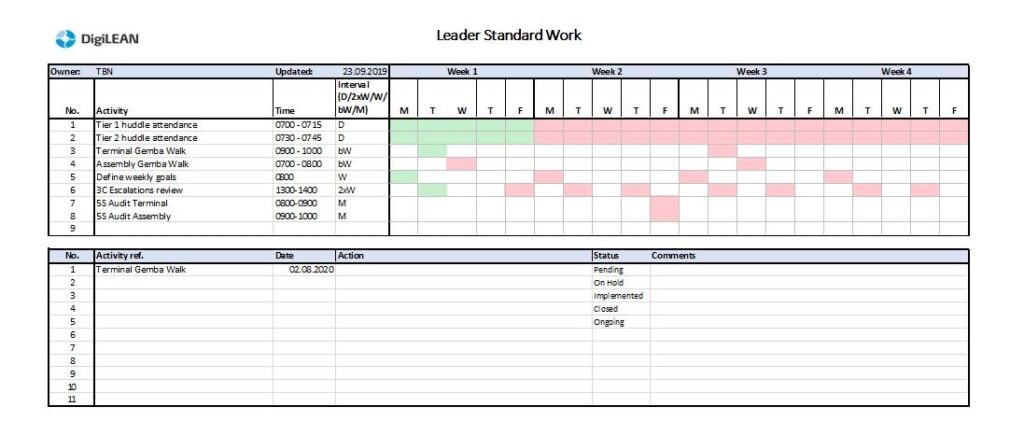- Product
Interactive boards. Fully customizable.
Capture, prioritize and follow up improvements.
Report and manage incidents. Visualize reports and statistics.
Operationalize your strategies and integrate your whole organization.
Access your tools in Microsoft Teams.
Customized templates. Problem solving, business development etc.
Manage project individually or in portfolios with visual and interactive tools.
Create and share best practices, one-point-lectures and standards.
Easy access to tasks, improvements and incidents.
Integrate DigiLEAN with your existing IT systems.
Meeting the demand of larger organizations.
High security level by default.
In less than 4 min
- Use Cases

Interactive tools for both shop floor and administration.
Visual project management.
Maintain standards. Manage incidents and discrepancies.
Manage tasks, integrate with problem-solving and continuous improvement.
Lean daily management tailored for healthcare.
Team task management, problem-solving and visualization.Case management, improvements, problem-solving, and strategy alignment.We have a LEAN solution for you too. Just ask!
We meet the demand of larger organizations.
- Pricing
- Shop Floor
- Product
Interactive boards. Fully customizable.
Capture, prioritize and follow up improvements.
Report and manage incidents. Visualize reports and statistics.
Operationalize your strategies and integrate your whole organization.
Access your tools in Microsoft Teams.
Customized templates. Problem solving, business development etc.
Manage project individually or in portfolios with visual and interactive tools.
Create and share best practices, one-point-lectures and standards.
Easy access to tasks, improvements and incidents.
Integrate DigiLEAN with your existing IT systems.
Meeting the demand of larger organizations.
High security level by default.
In less than 4 min
- Use Cases

Interactive tools for both shop floor and administration.
Visual project management.
Maintain standards. Manage incidents and discrepancies.
Manage tasks, integrate with problem-solving and continuous improvement.
Lean daily management tailored for healthcare.
Team task management, problem-solving and visualization.Case management, improvements, problem-solving, and strategy alignment.We have a LEAN solution for you too. Just ask!
We meet the demand of larger organizations.
- Pricing
- Shop Floor
What is Leader Standard Work?
Leader Standard Work (LSW) is a way to streamline the workday for managers and leaders. This happens through standardization of the activities. It may feel uncomfortable for a leader to do this. Their workday typically consist of making ad-hoc decisions and solve problems throughout the day. Their ability to follow a plan is limited because they cannot foresee issues landing on their table. But the risk is missing out on tasks critical for front line workers.
The content of Leader Standard Work
The Leader Standard Work contains a certain type of information.
The Owner is the leader who is executing the tasks. The Leader Standard Work shall also be revised on regular intervals, preferably with a higher-level manager.
The Activities are the description of tasks to be done, and most importantly, their interval. Some tasks are standard daily tasks, but other activities are to be done twice a week, weekly, bi-weekly or monthly. This is where activities normally slip because daily tasks become a routine.
The Charter on the right visualize when the activities shall be done, and by using colors, you can easily indicate whether or not the activity has been done.

On many occasions, you will encounter deviations, problems and possible learnings. The action list is used to capture and follow up issues. The learning effects are also a foundation for the Leader Standard Work revision.
Why use Leader Standard Work?
This is one of the tools you can equip the leaders with to help them better manage their role.
- With standardization, critical activities are not victim of ad-hoc daily management.
- The frontline workers get a more predictive leader behavior.
- Practice Lean Thinking
- Improve processes
- Develop problem solvers
Improved onboarding with LSW
A Leader Standard Work helps onboarding for new leaders. One of the major pitfalls with some organizations is to be critically dependent on one person. When that person leaves or moves on to another position, the standard often suffers. No one is taking responsibility. Audits are not being conducted. Boards is not being updated. Improvements stop, and teams return to just do like before.
To streamline the transition to a new leader, having a LSW will ease the onboarding of the next leader. Since the standard is already established, the routine is in place, the descriptions are understandable, the changes for succeeding and sustaining lean and continuous improvement is vastly improved.
Who should use LSW?
Leader Standard Work should not be limited only to shopfloor leaders and supervisors. This is something every leader in the organization should adopt. The higher up in the organization you get, the less standard work they have, and therefore it’s also more important to manage these.
The content of the standard work will be different, depending on their roles and position.
Challenges with LSW
Leaders and managers is less tolerant to be told what to do. The LSW is exactly that. A list of things to do. Without the higher level leaders buy-in, it’s too easy for middle- and lower level management to skip responsibilities, especially if there isn’t a culture for the frontline workers to call it out.
Physical or traditional LSW made in Word, Excel etc. is unable to capture and help leaders follow up actions. It’s easy to add new items, but equally easy to forget about the actions already there.
Adding the wrong activities will reduce the value of the Leader Standard Work. The focus should be on mission critical standard activities, and not generic tasks that doesn’t make sense.
Lack of transparency. Leaders keep the LSW for themselves, and stakeholders are kept outside. This impacts the trust, collaboration and motivation amongst the team members.
Digitizing workflows
With proper digital tools you can improve the workflow, add transparency to your teams and make the tools more available for everyday use.
It’s easier to maintain, add context, interactive action lists and follow up.
Combine the Leader Standard Work with online operation procedures, standards and reduce the time used to search and locate the extensive amount of files in your file system.
© 2024 DigiLEAN AS
